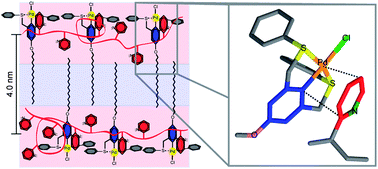Mesomorphic behavior induced by stacking interactions between poly(2-vinyl pyridine) and palladium pincer surfactants in the solid state†
Abstract
Combining poly(2-vinyl pyridine) (P2VP) with organometallic

Maintenance work is planned for Wednesday 1st May 2024 from 9:00am to 11:00am (BST).
During this time, the performance of our website may be affected - searches may run slowly and some pages may be temporarily unavailable. If this happens, please try refreshing your web browser or try waiting two to three minutes before trying again.
We apologise for any inconvenience this might cause and thank you for your patience.
* Corresponding authors
a
The Institute of Chemistry, The Center for Nanoscience and Nanotechnology, and The Lise Meitner-Minerva Center for Computational Quantum Chemistry, The Hebrew University of Jerusalem, Jerusalem 91904, Israel
E-mail:
roys@chem.ch.huji.ac.il
Fax: +972 2658 5345
Tel: +972 2658 6311
b
Department of Chemistry, Bar-Ilan University, Ramat Gan 52900, Israel
E-mail:
gil.goobes@biu.ac.il
Fax: +972 3738 4053
Tel: +972 3531 7390
Combining poly(2-vinyl pyridine) (P2VP) with organometallic

 Please wait while we load your content...
Something went wrong. Try again?
Please wait while we load your content...
Something went wrong. Try again?
I. Davidi, A. Semionov, D. Eisenberg, G. Goobes and R. Shenhar, Soft Matter, 2012, 8, 7393 DOI: 10.1039/C2SM25640A
To request permission to reproduce material from this article, please go to the Copyright Clearance Center request page.
If you are an author contributing to an RSC publication, you do not need to request permission provided correct acknowledgement is given.
If you are the author of this article, you do not need to request permission to reproduce figures and diagrams provided correct acknowledgement is given. If you want to reproduce the whole article in a third-party publication (excluding your thesis/dissertation for which permission is not required) please go to the Copyright Clearance Center request page.
Read more about how to correctly acknowledge RSC content.
 Fetching data from CrossRef.
Fetching data from CrossRef.
This may take some time to load.
Loading related content
